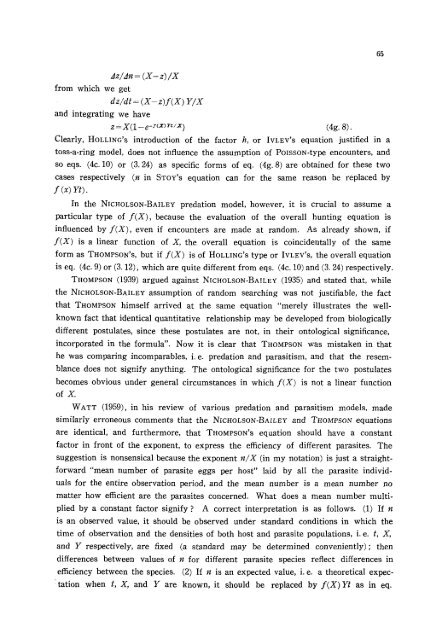A comparative study of models for predation and parasitism
A comparative study of models for predation and parasitism
A comparative study of models for predation and parasitism
You also want an ePaper? Increase the reach of your titles
YUMPU automatically turns print PDFs into web optimized ePapers that Google loves.
Az/An = (X-z)/X<br />
from which we get<br />
dz/dt = (X- z)f(X) Y/X<br />
<strong>and</strong> integrating we have<br />
z =X(1- e -f(I) r~/I) (4g. 8).<br />
Clearly, HOLLING'S introduction <strong>of</strong> the factor h, or IVLEV'S equation justified in a<br />
toss-a-ring model, does not influence the assumption <strong>of</strong> Po~ssoN-type encounters, <strong>and</strong><br />
so eqs. (4c. 10) or (3.24) as specific <strong>for</strong>ms <strong>of</strong> eq. (4g. 8) are obtained <strong>for</strong> these two<br />
cases respectively (n in STOY'S equation can <strong>for</strong> the same reason be replaced by<br />
f (x) Yt).<br />
In the NICHOLSON-BAILEY <strong>predation</strong> model, however, it is crucial to assume a<br />
particular type <strong>of</strong> f(X), because the evaluation <strong>of</strong> the overall hunting equation is<br />
influenced by f(X), even if encounters are made at r<strong>and</strong>om. As already shown, if<br />
f(X) is a linear function <strong>of</strong> X, the overall equation is coincidentally <strong>of</strong> the same<br />
<strong>for</strong>m as THOMPSON'S, but if f(X) is <strong>of</strong> HOLLING'S type or IVLEV'S, the overall equation<br />
is eq. (4c. 9) or (3. 12), which are quite different from eqs. (4c. 10) <strong>and</strong> (3. 24) respectively.<br />
THOMPSON (1939) argued against NICHOLSON-BAILEY (1935) <strong>and</strong> stated that, while<br />
the NICHOLSON-BAILEY assumption <strong>of</strong> r<strong>and</strong>om searching was not justifiable, the fact<br />
that THOMPSON himself arrived at the same equation "merely illustrates the well-<br />
known fact that identical quantitative relationship may be developed from biologically<br />
different postulates, since these postulates are not, in their ontological significance,<br />
incorporated in the <strong>for</strong>mula". Now it is clear that THOMPSON was mistaken in that<br />
he was comparing incomparables, i.e. <strong>predation</strong> <strong>and</strong> <strong>parasitism</strong>, <strong>and</strong> that the resem-<br />
blance does not signify anything. The ontological significance <strong>for</strong> the two postulates<br />
becomes obvious under general circumstances in which f(X) is not a linear function<br />
<strong>of</strong> X.<br />
WATT (1959), in his review <strong>of</strong> various <strong>predation</strong> <strong>and</strong> <strong>parasitism</strong> <strong>models</strong>, made<br />
similarly erroneous comments that the NICHOLSON-BAILEY <strong>and</strong> THOMPSON equations<br />
are identical, <strong>and</strong> furthermore, that THOMPSON'S equation should have a constant<br />
factor in front <strong>of</strong> the exponent, to express the efficiency <strong>of</strong> different parasites. The<br />
suggestion is nonsensical because the exponent n/X (in my notation) is just a straight-<br />
<strong>for</strong>ward "mean number <strong>of</strong> parasite eggs per host" laid by all the parasite individ-<br />
uals <strong>for</strong> the entire observation period, <strong>and</strong> the mean number is a mean number no<br />
matter how efficient are the parasites concerned.<br />
plied by a constant factor signify ?<br />
65<br />
What does a mean number multi-<br />
A correct interpretation is as follows. (1) If n<br />
is an observed value, it should be observed under st<strong>and</strong>ard conditions in which the<br />
time <strong>of</strong> observation <strong>and</strong> the densities <strong>of</strong> both host <strong>and</strong> parasite populations, i.e. t, X,<br />
<strong>and</strong> Y respectively, are fixed (a st<strong>and</strong>ard may be determined conveniently); then<br />
differences between values <strong>of</strong> n <strong>for</strong> different parasite species reflect differences in<br />
efficiency between the species. (2) If n is an expected value, i.e. a theoretical expec-<br />
:tation when t, X, <strong>and</strong> Y are known, it should be replaced by f(X) Yt as in eq.















